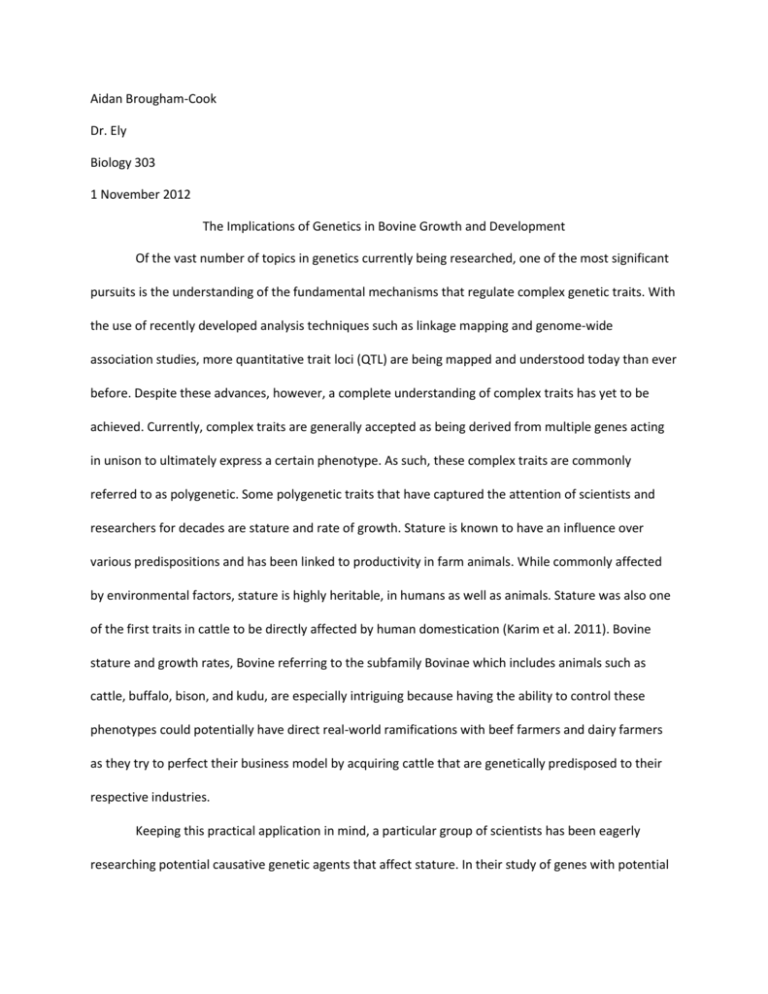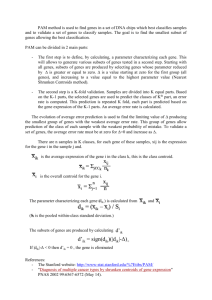Bovine growth genetics
advertisement

Aidan Brougham-Cook Dr. Ely Biology 303 1 November 2012 The Implications of Genetics in Bovine Growth and Development Of the vast number of topics in genetics currently being researched, one of the most significant pursuits is the understanding of the fundamental mechanisms that regulate complex genetic traits. With the use of recently developed analysis techniques such as linkage mapping and genome-wide association studies, more quantitative trait loci (QTL) are being mapped and understood today than ever before. Despite these advances, however, a complete understanding of complex traits has yet to be achieved. Currently, complex traits are generally accepted as being derived from multiple genes acting in unison to ultimately express a certain phenotype. As such, these complex traits are commonly referred to as polygenetic. Some polygenetic traits that have captured the attention of scientists and researchers for decades are stature and rate of growth. Stature is known to have an influence over various predispositions and has been linked to productivity in farm animals. While commonly affected by environmental factors, stature is highly heritable, in humans as well as animals. Stature was also one of the first traits in cattle to be directly affected by human domestication (Karim et al. 2011). Bovine stature and growth rates, Bovine referring to the subfamily Bovinae which includes animals such as cattle, buffalo, bison, and kudu, are especially intriguing because having the ability to control these phenotypes could potentially have direct real-world ramifications with beef farmers and dairy farmers as they try to perfect their business model by acquiring cattle that are genetically predisposed to their respective industries. Keeping this practical application in mind, a particular group of scientists has been eagerly researching potential causative genetic agents that affect stature. In their study of genes with potential effects on bovine stature, Karim et al. (2011) successfully identified eight candidate quantitative trait nucleotides (QTN) on chromosome 14, known as BTA14, that have a direct effect on bovine stature. It was determined that these eight QTNs directly affect the expression of seven genes on BTA14. Of the seven genes, the two most significant, as related to stature, are the PLAG1 gene and the CHCHD7 gene. The PLAG1 gene is an oncogene that codes for a transcription factor that is expressed in large quantities during fetal development but is down regulated after birth. PLAG1 also regulates a handful of growth factors, such as IGF2, which is a notable determinant of body size. CHCHD7 codes for an extensively expressed protein, but very little is known about its function. CHCHD7 has, however, been identified as a PLAG1 fusion partner in tumors, establishing a link between the two genes (fusion genes are the hybrid combination of two genes and are known to cause cancer). Of these two genes, PLAG1 is the most appealing for future Bovine research because it regulates growth factors, because genome-wide association studies in humans have mapped signals relating to height near to the PLAG1 gene, and because PLAG1 knockout mice display dwarfism (in the absence of other symptoms)(Karim et al. 2011). With the establishment of the PLAG1 gene as an attractive candidate for future bovine research, a group of researchers based out of New Zealand decided to investigate the phenotypic consequences of genetic variation within the PLAG1 gene. After phenotypic data such as daily growth rates, gross feed efficiency, and residual feed intake were recorded for 942 Bos taurus dairy calves, Littlejohn et al. (2011) studied the functional polymorphism, or SNP, ss319607402 on the PLAG1 gene and its effects on the recorded phenotypic data. Daily growth rates were determined by recording the Kleiber ratio of each animal over time, which is the daily weight gain per kilogram of body weight. Gross feed efficiency refers to the ratio of the mean daily feed intakes to the daily growth rates, and residual feed intake is the difference between the expected daily intake of the animal and the actual daily intake. After analysis, it was reported that the PLAG1 ss319607402 genotype displayed a significant association with the body weight of new-born calves, with peripubertal body weight, and with daily growth rate phenotypes; the growth rate per calf was also found to differ by genotype. These results suggest that the variation within the PLAG1 gene and bovine growth rates and size share a very strong association, which fuels further implications that the PLAG1 gene may be a significant regulatory agent in various mammalian species. Given the PLAG1 gene’s significant expression in the fetal tissues of mice and humans, these findings suggest that the PLAG1 gene influences fetal development (Littlejohn et al. 2011). They also suggest that the use of PLAG1 markers may allow for the selection of beef cattle with increased growth rates or dairy cattle with reduced sizes such that farmers may benefit from cattle with appropriate predispositions (Littlejohn et al. 2011). It is interesting to note that Karim et al. (2011) and Littlejohn et al. (2011) are not the only groups of scientists researching genetic influences in bovine cattle phenotypes. A study done by Lindholm-Perry et al. (2011) used a genome-wide association marker method to identify QTLs that affected bovine phenotypes such as average daily weight gain, average daily feed intake, and residual feed intake. Such an analysis yielded several regions along the BTA14 chromosome that displayed significant associations with at least one of the traits. Of these, two genes were selected as being the most logical for further testing: the LYPLA1 gene and the TMEM68 gene. LYPLA1 has been known to “deacylate ghrelin, a hormone involved in the regulation of appetite in the rat stomach, while TMEM68 is expressed in bovine rumen, abomasum, intestine and adipose tissue in cattle, and likely affects lipid biosynthetic processes” (Lindholm-Perry et al. 2011). After genotyping and association analysis, five markers were located near the TMEM68 gene, specifically between the TMEM68 gene and its neighbouring gene XKR4. Although little is known about the XKR4 gene, it is involved in the expression of red blood cell membrane proteins, which excluded it from initial pool of likely candidate genes. However, a mutation on this QTN could alter its function and therefore affect the specific phenotypes in question. These five markers that were identified displayed strong associations with average daily feed intake and average daily weight gain in this particular cattle population. It should be noted that due to the high linkage disequilibrium of these two genes, TMEM68 and XKR4, it cannot be determined which genes are contributing to the average daily feed intake or the average daily weight gain specifically. Further testing must be done with these markers before they can be considered for use in genetic predisposition selection (Lindholm-Perry et al. 2011). A follow up study done by Lindholm-Perry et al. (2012) later reported the identification of six additional markers along the BTA14 chromosome that were associated with residual feed intake in the same population of cattle as Lindholm-Perry et al. (2011). The follow up study also included more phenotypes to assess, such as adjusted fat thickness, tenderness, and ribeye area; unfortunately these did not produce any significant associations. The gene closest to the most significant SNP, BTB00557388, is the short chain dehydrogenase/reductase family 16C, member 5-like, but not much is known about this gene and its function, making speculation as to the gene’s overall effect on growth and stature difficult. This SNP showed the strongest association with residual feed intake after multiple test corrections, demonstrating a 3.6% influence in this particular cattle population. While these results are suggestive and have promise, further research is required before these markers can be utilized in the genetic selection of cattle (Lindholm-Perry et al. 2012). While the latter two studies conducted by Lindholm-Perry et al. (2011,2012) did not have as significant results as Karim et al. (2011) or Littlejohn et al. (2011), they both approached the same topic in different ways, and the result is a plethora of scientific data previously not known. It is now known that the PLAG1 gene may play a significant role in bovine growth rate and stature, specifically during infancy and pubescence. It is also known that there are several more potential markers on other genes on the BTA14 chromosome that, with further research, may lead to the discovery of even more exciting data. The applications of such research in the beef or dairy industry could be instrumental in changing modern farming techniques and may give considerable insight into more green, efficient farming methods of the future. This is a perfect example of collaboration within the scientific community that has both produced promising results and paves the way for future work in this field. Works Cited Karim, L., Takeda, H., Lin , L., et. al (2011). Variants modulating the expression of a chromosome domain encompassing plag1 influence bovine stature.Nature Genetics, 43(5), 405-413. doi: 10.1038/ng.814 Lindholm-Perry, A. K., Kuehn, L. A., Snelling, W. M., et al (2012). Genetic markers on bta14 predictive for residual feed intake in beef steers and their effects on carcass and meat quality traits. Animal Genetics, 43(5), 599-603. doi: 10.1111/j.1365-2052.2011.02307.x Lindholm-Perry, A. K., Kuehn, L. A., Smith, T. P. L., et. al (2011). A region on bta14 that includes the positional candidate genes lypla1, xkr4 and tmem68 is associated with feed intake and growth phenotypes in cattle. Animal Genetics, 43(2), 216-219. doi: 10.1111/j.1365-2052.2011.02232.x Littlejohn, M., Grala, T., & Sanders, K. , et. al (2011). Genetic variation in plag1 associates with early life body weight and peripubertal weight and growth in bos taurus. Animal Genetics, 43(5), 591594. doi: :10.1111/j.1365-2052.2011.02293.x








